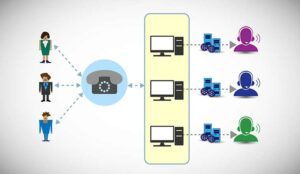What to look for when buying an Automatic Call Distributor (ACD):
A user-friendly and intuitive developer interface
You need this in order to rapidly create, deploy and modify applications to meet changing business needs, and also to create sophisticated routing scenarios as needed.
Sophisticated call routing options
These will enable you to route contacts based on agent skill sets, real-time conditions in the contact centre, priorities that your business managers define, data delivered from the network, information entered by callers, data in enterprise customer databases and so on.
Flexible voice-processing
This enables you to route calls based on caller input, using dual-tone multi-frequency (DTMF) or speech input as appropriate, as well as provide interactive voice response-based ‘automated’ phone services as customer needs dictate.
Real-time and historical reporting
Look for a system that offers up the tools and templates that allow you to create standard or bespoke reports, and display stats on screen or distribute them to users anywhere on the corporate network in order to effectively measure and improve performance.
A network-agnostic system
It is important to have the ability to operate in a proven mission-critical time-division multiplexing (TDM) environment, an Internet protocol (IP) environment, or a mixed environment with the ability to migrate from TDM to IP as business requirements demand.
Virtual contact centre support
Look for the ability to run a multi-site operation (possibly involving home-based workers) using the same business rules that apply to a single site operation. Also investigate whether you can centrally manage that multi-site operation with robust system management and administration capabilities.
Flexibility
Your new system should provide scalability (up or down) as well as the ability to incorporate /manage any outsourced functions as part of a central operation should the need arise – for instance, when seasonal outbound activity increases.
Advanced queue management
Check that your system provides customers with estimated wait times and with queue management tools such as scheduled call back.
Business continuity features
These should take advantage of redundancy options, such as a hot stand-by server, redundant shelf controllers, and extended battery back-up, and remote performance notification. Equally, these should run on a scalable, secure and reliable platform capable of supporting mission-critical operations.
Simple management and administration tools
These will make it fast and easy to manage hardware, agent groups and team assignments, system functions and settings, call routing admin details and alert messages.
Standards support
This will help you protect your investment. Does your chosen ACD use an industry-standard operating system, such as Windows? Does it support simple network management protocol (SNMP) to help you manage each contact centre system as a node on your network as well as monitor ACD status and activity?
Contributed by Isabel Montesdeoca, senior director of marketing: Europe and Africa at Aspect Software (www.aspect.com)
If you have any other ideas, why not drop us an email and we will see if we can add them in. There is a prize of a bottle of champagne for the best idea each month.
Author: Jonty Pearce
Published On: 5th Feb 2008 - Last modified: 12th Nov 2024
Read more about - Hints and Tips, Alvaria, Automatic Call Distributor (ACD)















